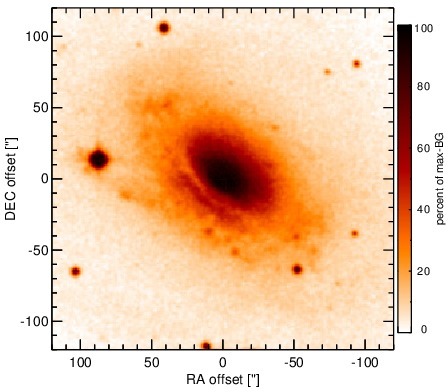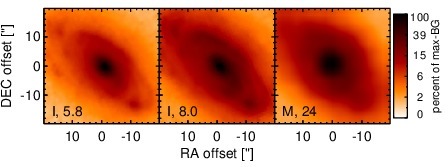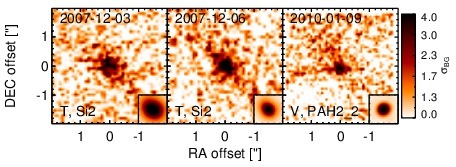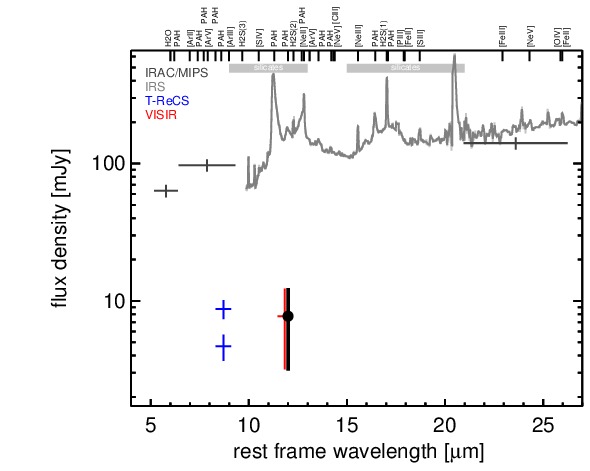Sasmirala Individual Information for NGC 3169
Description
NGC 3169 is an inclined spiral galaxy at a distance of D = 18.7 ± 3.4 Mpc (NED redshift-independent median) with a LINER nucleus [ho_search_1997-1]. At radio wavelengths, the nucleus appears a compact source with biconical extended emission along a PA~ 120∘ on arcsecond-scales [hummel_effects_1987, nagar_radio_2000] and as unresolved on subarcsecond scales [nagar_radio_2005]. The extended NLR is cospatial with the arcsecond radio structure [gonzalez_delgado_h_1997]. After IRAS, NGC 3169 was observed in the MIR with IRTF [devereux_infrared_1987] and Spitzer/IRAC, IRS and MIPS. An elliptical elongated nucleus embedded within the spiral-like host emission was detected in the corresponding IRAC and MIPS images. The IRS HR staring-mode spectrum exhibits prominent PAH 11.3 μm emission, a flat spectral slope in νFν-space, and silicate emission. Note however that no background subtraction was performed for this spectrum. The AGN-indicative high-ionization emission line [Ne V] is not clearly detected [dudik_spitzer_2009]. The nuclear region of NGC 3169 was imaged with T-ReCS in the Si2 filter during two nights in 2007 [mason_nuclear_2012] and with VISIR in the PAH2_2 filter in 2010 (this work). In all images, a compact MIR nucleus is weakly detected as well as biconical extended emission of ~ 2arcsec ~ 180 pc extent along a PA~ 51∘. Although the S/N is very low, we assume that this structure is real because it appears consistent in three different images of two different instruments. Surprisingly though, it is perpendicular to the radio and NLR emission. Our nuclear photometry is generally consistent with [mason_nuclear_2012] and on average ~ 95% lower than the Spitzer spectrophotometry. We conclude that the AGN in NGC 3169 is totally dominated by the host emission in the MIR on arcsecond scales (~ 350 pc).
- [devereux_infrared_1987] Nicholas A. Devereux, E. E. Becklin, and Nick Scoville. Infrared characteristics of the nuclei of normal galaxies . ApJ , 312 pp. 529–541, January 1987.
- [dudik_spitzer_2009] R. P. Dudik, S. Satyapal, and D. Marcu. A spitzer spectroscopic survey of low-ionization nuclear emission-line regions: Characterization of the central source . ApJ , 691 pp. 1501–1524, February 2009.
- [gonzalez_delgado_h_1997] Rosa M. Gonzalez Delgado, Enrique Perez, Clive Tadhunter, Jose M. Vilchez, and Jose Miguel Rodriguez-Espinosa. H II region population in a sample of nearby galaxies with nuclear activity. i. data and general results . ApJS , 108 pp. 155, January 1997.
- [ho_search_1997-1] Luis C. Ho, Alexei V. Filippenko, and Wallace L. W. Sargent. A search for ``Dwarf'' seyfert nuclei. III. spectroscopic parameters and properties of the host galaxies . ApJS , 112 pp. 315, October 1997.
- [hummel_effects_1987] E. Hummel, J. M. van der Hulst, W. C. Keel, and R. C. Kennicutt. The effects of interactions on spiral galaxies. III. a radio continuum survey of galactic nuclei at 1.49 GHz . A&AS , 70 pp. 517–530, September 1987.
- [mason_nuclear_2012] R. E. Mason, E. Lopez-Rodriguez, C. Packham, A. Alonso-Herrero, N. A. Levenson, J. Radomski, C. Ramos Almeida, L. Colina, M. Elitzur, I. Aretxaga, P. F. Roche, and N. Oi. The nuclear infrared emission of low-luminosity active galactic nuclei. AJ , 144 pp. 11, July 2012.
- [nagar_radio_2000] Neil M. Nagar, Heino Falcke, Andrew S. Wilson, and Luis C. Ho. Radio sources in low-luminosity active galactic nuclei. i. VLA detections of compact, flat-spectrum cores . ApJ , 542 pp. 186–196, October 2000.
- [nagar_radio_2005] N. M. Nagar, H. Falcke, and A. S. Wilson. Radio sources in low-luminosity active galactic nuclei. IV. radio luminosity function, importance of jet power, and radio properties of the complete palomar sample . A&A , 435 pp. 521–543, May 2005.
Images

Optical image (DSS, red filter). Displayed are the central 4 arcmin with North being up and East to the left. The colour scaling is linear with white corresponding to the median background (BG) and black to the 0.01% pixels with the highest intensity.

Spitzer MIR images. Displayed are the inner 40 arcsec with North being up and East to the left. The colour scaling is logarithmic with white corresponding to median BG and black to the 0.1% pixels with the highest intensity. The label in the bottom left states instrument and central wavelength of the filter in micron (I: IRAC, M: MIPS).

Subarcsecond-resolution MIR images sorted by increasing filter central wavelength. Displayed are the inner 4 arcsec with North being up and East to the left. The colour scaling is logarithmic with white corresponding to median BG and black to the 75% of the highest intensity of all images in units of sig_bg. The inset image (where present; either bottom or top right) shows the central arcsecond of the PSF from the calibrator star, scaled to match the science target. The labels in the bottom left state instrument and filter names (C: COMICS, M: Michelle, T: T-ReCS, V: VISIR).
SEDs


MIR SED. The description of the symbols in all the SED plots (where present) is the following: Grey crosses and solid lines mark the Spitzer/IRAC, MIPS and IRS data. The colour coding of the other symbols is as follows: green for COMICS, magenta for Michelle, blue for T-ReCS and red for VISIR data. Darker-coloured solid lines mark spectra of the corresponding instrument. The black filled circles mark the nuclear 12 and 18 micron continuum emission estimate from the data (where present). The ticks on the top axis mark positions of common MIR emission lines, while the light grey horizontal bars mark wavelength ranges affected by the silicate 10 and 18 micron features.